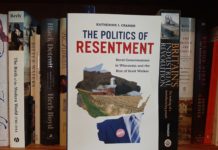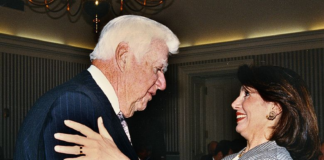Like so many authors and observers, Andrew M. Busch details Austin’s much-discussed and most obvious irony in his book, “City in a Garden.” This is, of course, the city’s enduring paradox that the Texas capital is at once both the state’s most liberal city while also its most racially segregated – more so today in fact than it was at the height of Jim Crow.
But Busch goes beyond that well known irony, a standard lament shared over local craft beer at any liberal gathering or party on the city’s west side. And in a little more than 250 pages, Busch explores the hidden irony, the paradox so rarely discussed: this is the racism that persists despite its frequent condemnation by a liberal, all-Democrat city council, a globally esteemed university, countless task forces and committees, a vibrant media ecosystem and shelves of books and reports on the subject written over decades.
“The failures to produce truly cross-cultural dialogue, in planning, in environmental consciousness, in the battles for the city’s future are all rooted in a history that is acknowledged but that does not actually inform the present,” argues Busch.
It is an unsettling and uncomfortable conclusion that Busch makes. Before reaching that conclusion, however, the book gets quickly to Austin’s “original sin,” the first comprehensive city plan of 1928. Racism and a gulf in social class and status existed between white and African Americans before then, “although residential segregation was not intense.” That was to change after 1928 when the city adopted its first general plan, which quite openly called for a “negro district,” to be realized by denial of city services to blacks in the areas where many then lived, including today’s Clarksville and Wheatsville neighborhoods, as well as the region along Waller Creek now dominated by the new Dell Seton Medical Center and the older Austin Convention Center. This was the period, post-World War I, when Austin’s Hispanic population began to grow as well, driven in part for the need for labor as African-American’s began the “great migration” to northern industrial cities. “Anglo perceptions of Austin’s racial hierarchy changed from dyadic (whites and blacks) to triadic (whites, Mexicans and blacks),” Busch notes. While legal restrictions on Hispanics were not as overt, property agents, landlords and loan officers all observed the informal color line and the racial geography today defined by the I-35 freeway was largely in place by the 1940s.
The miseries and discrimination visited upon Austin’s minorities before the civil right era and after are well chronicled in the book, as they are elsewhere. Two incidents, however, stand out and deserve emphasis in this brief review.
In a 1919 incident, an early organizer for the NAACP was beaten in Austin by a group that included police. After the NAACP agent, John R. Shallady, died of his injuries, an outcry followed in the national press. In response, then-Gov. William P. Hobby defended the beating and authorized harassment of the NAACP throughout the state. Austin’s chapter was disbanded.
In early 1950s Austin, Brackenridge Hospital on the border of East and West Austin was the only hospital serving blacks, though white nurses where not required to treat African Americans and black doctors were not allowed to practice. When Carl Downs, president of Samuel Huston College (today’s Huston-Tillotson University) was rushed to the hospital with appendicitis, he was denied access to an emergency room. He died awaiting surgery.
Busch also gives thoughtful attention to Austin’s history as a center of university-led research and its evolution into today’s well known technology hub. Much will be familiar to readers: from the foundation of the defense electronics firm Tracor in 1955 to the establishment of America’s first computer research consortia, the Microelectronics and Computer Technology Corp. (or MCC), in 1982, and all that has ensued since. Busch does, however, push back the date and origins of Austin’s technology earlier than many narratives.
In “City in a Garden” it begins in 1948 with an economic development roadmap developed by New York planning consultant Richardson Wood, who was hired by the Austin Chamber of Commerce. Eschewing the prevailing sentiment among many leaders of U.S. cities in favor of industry and manufacturing, Wood saw the post-World War II future of government research and spending and the promise of an economy based on skilled and well educated labor. His report to the city, prepared in less than a week, was ultimately embraced by the city council. Because of Wood, Bush writes, Austin’s leaders… “actively sought economic growth through a variety of models focused on distinct local advantages: low utility rates and cost of living, a friendly business climate, unique place-based characteristics (such as the Highland Lakes region and modern suburban homes), a highly skilled labor market, and especially the University of Texas, which became the central feature in Austin’s attempts to attract knowledge capital in the 1950s and 1960s.”
But it is the larger aperture Busch opens across Austin’s technology story that begins to reveal the origins of the hidden irony, the question implied throughout the book as to why Austin can’t fix a history of injustice that no one really denies. For Busch, today’s tech story was really made possible by an earlier tale of technology, the hydrotechnology that created the storied and watery oasis that is as different from the rest of Texas’ landscapes as the topless sunbathing in Barton Springs is in contrast with public sensibilities elsewhere in the state. Uniquely, Busch suggests, Austin’s natural beauty was neither inherited nor bequeathed by nature. At least not directly. The founders of modern San Francisco or Seattle found the breathtaking beauty of bays and hills upon arrival, the point would be. Denver, similarly, had the snowcapped Rockies as backdrop when the first gold miners showed up in the mid-19th Century. Chicago had Lake Michigan and New Orleans had the Mississippi and the Gulf of Mexico when the first civic planners began to envision an urban transformation.
Not so in Austin, an arid place straddling the flat prairie to the east and the beginning of the rocky limestone Edwards Plateau to the west. The flows in the Colorado River were – and are – sporadic and Austin was prey to repeated and violent flooding in its early history. The geology was as unaccommodating as the geography and the first two dams built at the site of today’s Tom Miller dam creating Lake Austin were both swept away when their foundations catastrophically failed to hold in the chalky and fractured limestone – killing several 47 in 1900 and again failing after it was rebuilt in 1915.
At risk of oversimplifying Busch’s complex and elegant argument, Austin’s physical beauty does not emerge from the wilderness nor is most of Austin’s “nature” truly “natural.” Rather, it is manufactured, wrested from a harsh landscape by visionary civic pioneers. With substantial help from the federal government, they ultimately created the waterscape that defines Austin today.
Often described as the “crown jewel” of Austin, Zilker Park’s Barton Springs Pool was created in 1918 after the city bought it, dammed it and built the concrete frame that shapes the popular pool today into a space slightly larger than two football fields. The Tom Miller dam of 1940 creates Lake Austin, now lined with some of America’s priciest mansions, including those owned by Dennis Quaid, Mathew McConaughey and until recently Sandra Bullock. Upstream of Lake Austin, of course, is the meandering Central Texas necklace of Lake Travis, Lake Marble Falls, Lake LBJ, Inks Lake and Lake Buchanan, all created by the Lower Colorado River Authority, or LCRA, formed in 1935 by the Texas Legislature with the encouragement of Austin’s civic leadership and then-Congressman Lyndon Baines Johnson. The locket at the bottom of this chain was created in 1960 by the Longhorn Dam. The result is the most-photographed icon of modern Austin, Lady Bird Lake, with its paddleboarders, kayakers and rowers always at the center of any portrait of urban placidity.
That Austin’s beauty is constructed does not detract from the masterpiece of gardening gthat Austin has become. And Busch does not make light of the sheer enormity of Austin’s transformation, from the planning to the engineering to the construction over decades. And it is here the reader finds the nascent environmental movement when citizens, led by the Audubon Society, mobilized in the late 1950s to successfully thwart plans to privatize the north and south shores of what became Lady Bird Lake – the spots now defined by running trails, picnic areas and the hybrid dog park/concert venue.
But it is also here within the concomitant creations of the waterscape beginning with Barton Springs in 1918, and the knowledge economy that dates to Wood’s plan of 1948, that the roots of Austin’s hidden paradox begins to emerge.
“Importantly, the city’s economy and geography were also deliberately planned to attract knowledge workers, develop desirable spaces for them to use, and to keep them away from the city’s industrial and minority residents,” Busch writes. “As with water, the city’s growth model yoked suburbanized space, knowledge labor, and environmental amenities to whiteness.”
Into the 1970s and 1980s, Busch describes the rise of an Austin environmental movement that emphasized the preservation of open space, the mobilization of neighborhood groups and constraints on development that, however laudable, ignored “social justice or cross-class concerns.” Indeed, activists from either side of I-35 have found moments of common cause, as in 1997 when they collectively mobilized to force the removal a sprawling set of gasoline storage facilities in east Austin. But more emblematic was the arrival of recycling in Austin in the 1970s, spurred by the nationwide environmental movement beginning in the era. The recycling center, sited on East Sixth Street, was opened without so much as a public hearing due to the much more lenient zoning laws on the east side. Backing up to a densely built residential neighborhood, it recycled over 100 tons of paper and cardboard and tons of aluminum per day. It was ultimately closed, but almost entirely through the efforts of the local movement known as PODER, for “People Organized in Defense of Earth and her Resources.” And PODER got little help from mainstream environmentalists.
“By attempting to co-opt Eastside space for environmental purposes, using existing segregated districts in public planning, and imagining different uses for public water space,” Busch writes, “mainstream environmentalists demonstrated a subtle yet important willingness to protect and enhance nature at the expense of minority interests.”
But it does not have to be that way, the author argues, in a conclusion that acknowledges the accelerating challenges of gentrification and property taxes that in many cases are completing the ruination of Austin’s long-established but increasingly fragile communities of color. He calls for development of local chains of production to create jobs in manufacturing and services, a redefinition of sustainability to include affordable housing and consideration of policies that have worked in other cities: rent controls, land trusts, direct subsidies, tax freezes, levies on big box stores, and higher taxes on short term rentals.
“The new emphasis on urbanity in twenty-first-century Austin exposes the limits of sustainability,” Busch argues in a final chapter that will surely discomfort many an Austin liberal. “As such, it of utmost importance to cast off the idea that the pristine natural world is somehow unsullied or that it can be imagined as something that exists outside of human relationships and struggles.”
Whether an understanding of Austin’s past can really inform its present will remain an open question. One can imagine worst places to start pondering the future than Busch’s insightful if troubling book.
If you like what you’ve been reading, please click here to subscribe and we will send you updates and our newsletter.






